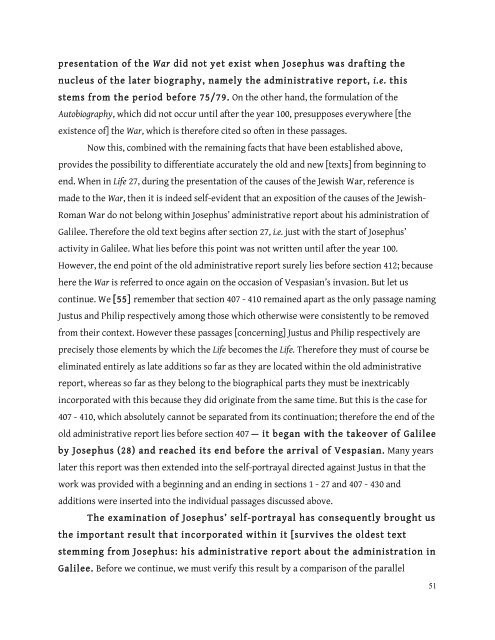The Jewish Historian Flavius Josephus: A Biographical Investigation
The Jewish Historian Flavius Josephus: A Biographical Investigation
The Jewish Historian Flavius Josephus: A Biographical Investigation
Create successful ePaper yourself
Turn your PDF publications into a flip-book with our unique Google optimized e-Paper software.
presentation of the War did not yet exist when <strong>Josephus</strong> was drafting the<br />
nucleus of the later biography, namely the administrative report, i.e. this<br />
stems from the period before 75/79. On the other hand, the formulation of the<br />
Autobiography, which did not occur until after the year 100, presupposes everywhere [the<br />
existence of] the War, which is therefore cited so often in these passages.<br />
Now this, combined with the remaining facts that have been established above,<br />
provides the possibility to differentiate accurately the old and new [texts] from beginning to<br />
end. When in Life 27, during the presentation of the causes of the <strong>Jewish</strong> War, reference is<br />
made to the War, then it is indeed self-evident that an exposition of the causes of the <strong>Jewish</strong>-<br />
Roman War do not belong within <strong>Josephus</strong>’ administrative report about his administration of<br />
Galilee. <strong>The</strong>refore the old text begins after section 27, i.e. just with the start of <strong>Josephus</strong>’<br />
activity in Galilee. What lies before this point was not written until after the year 100.<br />
However, the end point of the old administrative report surely lies before section 412; because<br />
here the War is referred to once again on the occasion of Vespasian’s invasion. But let us<br />
continue. We [55] remember that section 407 - 410 remained apart as the only passage naming<br />
Justus and Philip respectively among those which otherwise were consistently to be removed<br />
from their context. However these passages [concerning] Justus and Philip respectively are<br />
precisely those elements by which the Life becomes the Life. <strong>The</strong>refore they must of course be<br />
eliminated entirely as late additions so far as they are located within the old administrative<br />
report, whereas so far as they belong to the biographical parts they must be inextricably<br />
incorporated with this because they did originate from the same time. But this is the case for<br />
407 - 410, which absolutely cannot be separated from its continuation; therefore the end of the<br />
old administrative report lies before section 407 — it began with the takeover of Galilee<br />
by <strong>Josephus</strong> (28) and reached its end before the arrival of Vespasian. Many years<br />
later this report was then extended into the self-portrayal directed against Justus in that the<br />
work was provided with a beginning and an ending in sections 1 - 27 and 407 - 430 and<br />
additions were inserted into the individual passages discussed above.<br />
<strong>The</strong> examination of <strong>Josephus</strong>’ self-portrayal has consequently brought us<br />
the important result that incorporated within it [survives the oldest text<br />
stemming from <strong>Josephus</strong>: his administrative report about the administration in<br />
Galilee. Before we continue, we must verify this result by a comparison of the parallel<br />
51
















